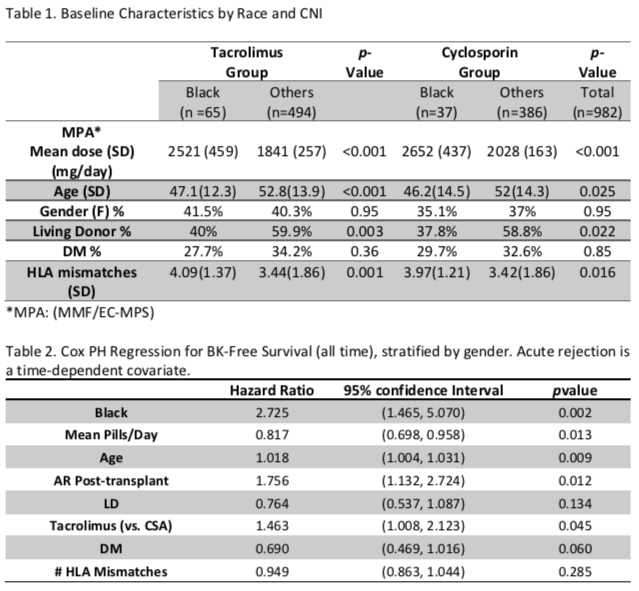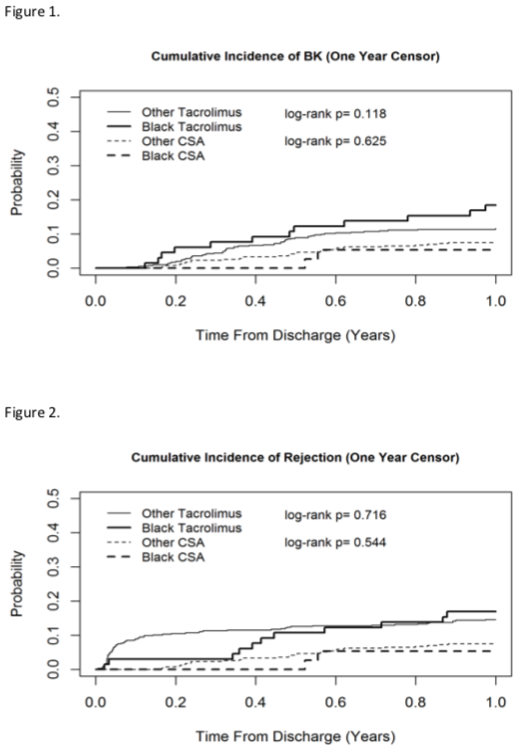BK Virus Infection Disparity between Black and Other Races; Do Not Blame the Mycophenolic Acid
1Medicine, University of Minnesota, Minneapolis, MN, 2Complex Care Analytics, Fairview Health Services, Minneapolis, MN, 3Surgery, University of Minnesota, Minneapolis, MN
Meeting: 2019 American Transplant Congress
Abstract number: D171
Keywords: African-American, FK506, Outcome, Polyma virus
Session Information
Session Name: Poster Session D: Non-Organ Specific: Disparities to Outcome and Access to Healthcare
Session Type: Poster Session
Date: Tuesday, June 4, 2019
Session Time: 6:00pm-7:00pm
 Presentation Time: 6:00pm-7:00pm
Presentation Time: 6:00pm-7:00pm
Location: Hall C & D
*Purpose: Disparities in kidney transplant outcomes between black recipients and others continue to exist. We sought to examine the impact of race and the differential MPA dosing on the risk of BK viral infection (BKVI) in primary kidney transplant recipients.
*Methods: The University of Minnesota uniformly uses induction with rabbit anti-thymocyte globulin (rATG) and steroid free maintenance. Maintenance regimens consist of a Calcineurin inhibitor (CNI) agent and MPA. Black recipients systematically received higher doses of MPA. We included all primary adult KTA recipients from 2007 on, as this was when routine BK screening began. Patients were compared separately by race and CNI agent used. Kaplan-Meier curves were produced to compare cumulative incidence of BK and rejection within one year of transplant. A Cox PH regression model, stratified by age was used to analyze all-time BK free survival. Initial acute rejection post-transplant was considered as a time-dependent covariate. MPA usage was considered as the mean number of pills/day.
*Results: Black recipients constituted 10.4% of the cohort. They received higher doses of MPA, had less frequent living donors and more HLA mismatches (Table 1). The one-year cumulative incidence of BKVI and Acute Rejection are depicted in (Figure 1 and 2). In the adjusted multivariate Cox proportional hazards model, black race was associated with an increased risk of BKVI (within one year) as compared to others (HR 2.73, 95% CI (1.47, 5.07) p 0.002). Higher amounts of MPA was associated with decreased risk. Tacrolimus use as compared to cyclosporin and acute rejection were significantly associated with increased risk of BKVI (Table 2).
*Conclusions: In the settings of induction with rATG and steroid free maintenance, the risk of incident BKVI is higher for black recipients, Tacrolimus use and decreased MPA dosage. Efforts to personalize the immunosuppression regimens and to identify the sources of the outcome disparity between black and others are much needed.
To cite this abstract in AMA style:
Raj N, Spong R, Jackson S, Vakil V, Keys D, Finger E, Riad S. BK Virus Infection Disparity between Black and Other Races; Do Not Blame the Mycophenolic Acid [abstract]. Am J Transplant. 2019; 19 (suppl 3). https://atcmeetingabstracts.com/abstract/bk-virus-infection-disparity-between-black-and-other-races-do-not-blame-the-mycophenolic-acid/. Accessed December 13, 2025.« Back to 2019 American Transplant Congress


